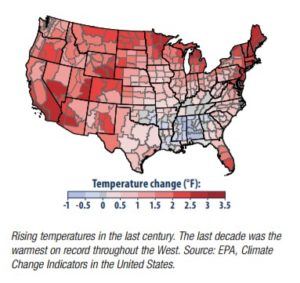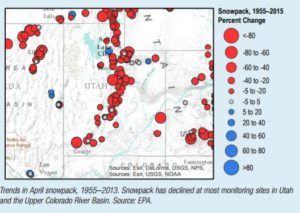Let It Snow?

Carving up the slopes on Alta’s pristine powder may prove to be a much more difficult pursuit toward the end of the 21st century with snowpack decreasing significantly over the past 50 years.
Let it Snow?
Carving up the slopes on Alta’s pristine powder may prove to be a much more difficult pursuit toward the end of the 21st century with snowpack decreasing significantly over the past 50 years according to recent studies.[1] Can they do enough turn the tide and help preserve Utah’s claim to “the greatest snow on earth”?
Climate change and Alta Ski Resort
As noted by the EPA [2], the last decade in the western US is the warmest on record. General warming trends lead to 1) less precipitation falling to the earth as snow and 2) snow melting more quickly.1,[3]
These two factors combine to decrease the overall snowpack1 which can shorten the winter tourism season and lead to a decrease in topline revenue for resorts like Alta.1
Alta’s relatively high elevation[4] buys them more time than many of their competitors, but with current trends, it may only be a matter of time before they start to feel significant pain.
What is Alta doing?
Alta acknowledges the impacts climate change can have on their business and has a five point strategy in place to address short and mid-term concerns.[5]
1) Educating patrons and the public
Alta has established programs to educate guests and the public about the impact of climate change on winter sports and how they can help reduce greenhouse gas emissions.[6]
2) Raise policy-maker awareness
Alta realizes that state and federal climate change legislation is critical for reversing warming trends. Alta and other Utah resorts have partnered with Rhode Island Senator Whitehouse to raise the profile of this issue in congress.[7]
3) Advocate for reduction of greenhouse gas emissions
Alta is among 108 ski resorts to sign the BICEP Climate Declaration. This calls on policymakers to confront climate change issues and take a deeper look at the economic implications of warming temperatures.7
4) Support science-based solutions to climate change (including renewable energy technologies)
While this is expressed as a key point to Alta’s strategy, I did not note any specific efforts they are currently pursuing to push this mission forward in public sources. I will address this as a potential area they can improve later in this response.
5) Invest in more efficient practices and technologies; measure and report emission reductions to stakeholders
Alta committed to a 20% carbon reduction goal by the year 2020. They annually report on their progress to stakeholders.5
What other steps can Alta take?
Youth education
While Alta is focusing educational efforts on patrons and the general public as a whole, I believe the most important area of focus for their educational efforts should be on youth. The creation of school educational programs has the potential impact the attitudes of the rising generation.
Inorganic expansion further north
Some investors are betting that the establishment of resort further north will leave them as “the only game in town”8 when temperatures warm enough to severely impact the resorts further south. Some of Alta’s competitors have diversified the impact of weather variability by acquiring resorts further north. One example is Vail Resorts which announced a $1 billion deal in August 2016 to buy Whistler Blackcomb in British Columbia as a hedge.[8] Alta’s owners could consider investing in a similar manner.
Encourage entrepreneurship for science-based solutions
Investing and supporting the development of science based solutions is an area of their current strategy they can improve upon. In 2015, the U.S. Forest Service began a threat assessment study to help identify specific vulnerabilities in the intermountain west.[9] Once results have been released, Alta’s PE/VC owners could consider setting up a climate change innovation lab or investing seed capital to support development of technologies that could target threats noted in this study.
Questions
Given the rapid impact of climate change and the large buy in from society as a whole needed to reverse the tide of climate change, is it worth significant investment by Alta and its PE/VC owners to try to preserve Alta’s current footprint or should they treat this as a depleting asset with a finite life?
Does Alta’s PE/VC owner have a social responsibility to continue to invest, even if they deem it to be not in their best economic interest?
(797 words)
[1] United States Environmental Protection Agency, “What Climate Change Means for Utah”, EPA 430-F-16-046, https://19january2017snapshot.epa.gov/sites/production/files/2016-09/documents/climate-change-ut.pdf, accessed November 2017
[2] United States Environmental Protection Agency, “Climate Change Indicators in the United States”, https://www.epa.gov/climate-indicators, accessed November 2017
[3] United States Environmental Protection Agency, “Climate Impacts on the Southwest”, https://archive.epa.gov/epa/climate-impacts/climate-impacts-southwest.html, accessed November 2017
[4] Alta Ski Area, https://www.alta.com/the-mountain/mountain-info, accessed November 2017
[5] Alta Ski Area, https://www.alta.com/alta-environmental-center/our-efforts, accessed November 2017
[6] Alta Environmental Center, https://www.alta.com/alta-environmental-center, accessed November 2017
[7] Sheldon Whitehouse (U.S. Senator – Rhode Island), “WHITEHOUSE HEARS FROM UTAH SKIERS, SKI INDUSTRY ON EFFECTS OF CLIMATE CHANGE”, https://www.whitehouse.senate.gov/news/release/whitehouse-hears-from-utah-skiers-ski-industry-on-effects-of-climate-change
[8] Bloomberg, https://www.bloomberg.com/news/articles/2016-12-16/saving-skiing-three-men-bet-big-on-climate-change-proof-resort, accessed November 2017
[9] Deseret News, https://www.deseretnews.com/article/865630269/Whats-the-impact-of-climate-change-on-Utah-Study-will-try-to-find-out.html, accessed November 2017





I agree that declining snowpack undermines Alta’s value proposition, but it occurs to me that there are adaptation measures – in addition to the mitigation measures mentioned above – that can help soften the blow of climate change with more immediacy.
For instance, while man-made snow is never as good as the real thing, Alta can invest in high efficiency snow making equipment to create denser snowpack. In 2015 – one of Alta’s stingiest years in recent memory, with only about 60% of typical annual snowfall – Alta relied heavily on machine-made snow to sustain snowpack and skier volumes through the ski season.[1]
Other measures include seeding clouds with silver iodide to augment precipitation capacity and using insulating blankets to preserve snow from previous seasons. In cloud seeding, resorts inject particles of silver iodide into clouds. The water droplets that comprise clouds adhere to the injected particles, which are required for snowflake formation. This process aims to increase the precipitation and snow generation capacity of clouds, thereby contributing to denser snowpack. Cloud seeding does have limitations, however, requiring cloud coverage and specific temperature thresholds.[2]
With insulting blankets, resorts can also adapt to climate change challenges by leveraging snowpack from prior seasons. Sochi, for example, employed this approach heading into the 2014 Winter Olympics in order to preserve a foundation of snow and hedge against a potential dearth of snowfall during the Olympic season.[3]
While these actions are blunt tools for solving the overarching climate issues facing resorts like Alta, they may be the most effective near-term measures resorts can take to alleviate their pressing supply chain issues.
[1] It’s unheard of Alta missed 100-inch base. Mike Gorrell The Salt Lake Tribune · April 30, 2015 12:45 pm – http://archive.sltrib.com/article.php?id=2446854&itype=CMSID
[2] It’s Not Magic On The Mountain, It’s A Rain-Making Machine. Lauren Sommer – https://www.npr.org/2014/01/09/261070150/its-not-magic-on-the-mountain-its-a-rain-making-machine
[3] Sochi’s Olympic Snow Stored Under Tarps Since Last Winter. Kirit Radia – http://abcnews.go.com/International/sochis-olympic-snow-stored-tarps-winter/story?id=21023724
Very interesting article! To answer the question you pose on whether Alta’s PE/VC owners have a social responsibility to continue to invest, in the last couple of years there has been a growing trend on more conscious investments within the PE industry. Limited Partners (“LPs”) have become more strict on evaluating their General Partners (“GPs”, the funds) from an Environmental, Social and Governance (“ESG”) lens. As an example, last year in PEI’s responsible investment forum, Kathleen Bacon, Managing Director at LP HarbourVest Partners, said “if we thought that somebody was not, practicing good governance or looking at the social impact of their businesses, we would not invest”.[1] It might be naive to think that Alta’s PE/VC owners will continue to invest if it does not make financial sense, but if LPs keep pushing funds to consider the environmental and social side of their investments, there might be a future in which funds favor impact vs. financial return.
[1] LPs: ESG is non-negotiable. Isobel Markham – https://www.privateequityinternational.com/lps-esg-is-non-negotiable/
I like your assessment of the threat climate change poses to Alta’s business model. What I would like to know more about, though, it how significant Alta’s contribution to climate change is. Further, are the steps Alta is taking to prevent climate change effective? Are the main culprits of climate change being addressed by Alta’s efforts? I am also eager to get your thoughts on how Alta can adapt its supply chain to account for climate change. How viable is the idea of producing more “fake snow” on the mountain? Can Alta change its business model to be less reliant on inputs subject to climate change? Can Alta turn warmer temperatures into a strategic advantage, such as by attracting more visitors for non snow-based activities?
I like your topic and the implications you raised. To your first question — 1) I don’t believe Alta’s management should try to evolve and sustain long-term viability. First, Alta is a small- to mid-sized resort whose value proposition rests on allowing only skiers to purchase lift tickets. (Alta is 1 of 3 resorts in North America to offer this value) This unique trait makes Alta standout among elite skiers in North America since it is the only major resort in the Rocky Mountains to offer this point of difference (POD). Translating Alta’s POD elsewhere would be challenging as Alta would be essentially prohibiting half of its potential consumers from purchasing lift tickets. (skiers comprise roughly half of the winter sport consumer base) Second, Alta’s mid-tier size and moderate revenue stream would force it to incur debt to finance a shift north. Securing such funds would not be cheap, especially when regional impacts due to climate are so uncertain. Thus, I see Alta as a dying asset — management should treat it accordingly.
Very interesting article on the impact of climate change on Alta! The decreasing snow volume interrupts the sustainability of Alta’s supply chain, and forces it to expand its supply chain further to the north. I agree that Alta has been doing a great job educating its customers about global warming and working with government to improve relevant policies in order to slow down the climate change. I wonder if Atlas could take any actions to redesign its supply chain strategy to adapt to the climate change, or even rebuild its business model through innovations and technologies to reduce the impact of climate change on its bottom line.